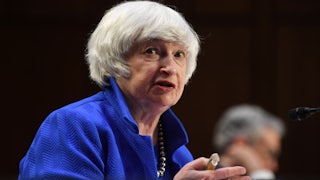Washington, D.C., is the only place where the word reconciliation is an invitation to fight. I advised the Democrats last week (“Nobody Gives a Rat’s Ass Whether the Debt Ceiling Gets Folded Into Reconciliation”) to be magnanimous in their victory over Senate Minority Leader Mitch McConnell, who blinked in a standoff over whether to raise the debt ceiling. McConnell had been insisting that the Democrats put the debt ceiling increase into the $3.5 trillion “Build Back Better” reconciliation bill and then pass it by majority vote without any votes from Republicans. (Reconciliation bills can’t be filibustered.) But under pressure, McConnell agreed to help lift the debt ceiling just enough to keep the government running until December 3, leaving Democrats plenty of time to fold the next debt-limit increase into the reconciliation bill. The absence of sufficient time was, Democrats had said, the reason not to put the debt ceiling increase into reconciliation.
What I should have written was that the absence of time was the Democrats’ stated reason not to put the debt ceiling increase into reconciliation. It wasn’t their real reason. Their real reason, which Democrats can’t say out loud because it involves a mild deception, is even more trivial and idiotic than their stated reason. It concerns whether the increase in the debt limit is expressed as a number or whether it’s expressed more vaguely as a deadline for resolving the matter in the future.
If the debt limit is included in reconciliation, Senate rules dictate that it must be expressed as a number, and certain Democratic moderates fret that Republicans will use that number against them in the midterm elections. This reason for opposing a debt ceiling increase through reconciliation is supposed to be a secret. But House Budget Committee Chairman John Yarmuth blurted it out last month. “We can do it through reconciliation,” Yarmuth said on MSNBC. “Leadership has said they don’t want to do that. The reason is, if we do that through reconciliation, we actually have to specify a number.“ Immediately, McConnell’s press secretary and communications director pounced. But almost nobody twigged that the Democrats had just confessed that their stated reason for wanting to raise the debt ceiling outside reconciliation was bullshit. The real reason was that they wanted to hide what the debt ceiling was.
The debt ceiling, you see, is a very big number. Right now it’s—you might want to sit down for this—about $29 trillion.
Are you OK? Do you need smelling salts? A glass of water? No? You say you don’t care? Then you aren’t thinking like a moderate congressional Democrat.
The Democratic moderates fear that if they go on record voting for an even bigger debt ceiling number than today’s $29 trillion, their Republican opponents in 2022 will bludgeon them with it. Never mind that the national debt, which drives this conversation, is never a secret. Never mind that their Republican opponents will likelier bludgeon them over the budget deficit, which (unlike the debt ceiling) is something voters actually understand. “It’s silly, I know,” a Democratic senator explained to me. “But the margins are really tight in some of these districts.” As Emily Dickinson might say: The heart fears what it fears.
The clinical term for this fear is math anxiety, or arithmophobia. Symptoms include an elevated heart rate, upset stomach, and an inability to concentrate. It was perhaps this last symptom that prompted Senate Majority Leader Chuck Schumer to throw a hissy fit Thursday about McConnell trying to force Democrats into “a drawn-out, convoluted, and risky reconciliation process” that “was simply unacceptable to my caucus.” McConnell answered with a hissy fit of his own, complaining in a letter Friday to President Biden that Schumer’s speech “poisoned the well” and that he would hereafter furnish no more Republican votes to extend the debt limit. Which, if he sticks to that, means the Democrats will be compelled to include the much-feared deficit ceiling number in the reconciliation bill. Which, in spite of it being something McConnell wants, is not an especially troubling prospect.
Really, as The New York Times editorial board pointed out over the weekend, there shouldn’t be a debt limit at all. Having one has seldom restrained debt accumulation. The United States started out with a variety of limits on individual types of debt, such as war bonds or bonds to build the Panama Canal. By 1930, the inflexibility of this arrangement had become a problem, prompting President Herbert Hoover to move toward aggregating these limits. That culminated under President Franklin Roosevelt in the first unified debt ceiling: $65 billion in 1941, or about $1.3 trillion in today’s dollars. Four years later, World War II had pushed that up to $300 billion, or $5.8 trillion in today’s dollars.
Stupid fights over the debt limit made their debut during the Eisenhower administration, when Congress declined Ike’s 1953 request to raise it significantly and instead passed three temporary hikes, then lowered it in 1957 to $275 billion. Then, as now, limiting the debt ceiling was believed to “compel more economy of efficiency” and “better management of money,” in the words of Democratic Representative George H. Mahon of Texas, a notorious tightwad. Then, as now, the debt ceiling was a clumsy and ineffective tool to impose thrift. By 1962, the debt ceiling was back to its nominal level during World War II. The debt limit has been climbing ever since.
Growing partisan rancor over the debt limit culminated in 2011, when a prolonged struggle by the Obama administration to get Congress to approve an increase prompted Standard & Poor’s to downgrade its credit rating on U.S. Treasury bills. No credit agency had ever done this before, and none has done so since (though S&P has recently threatened that it will act again if the current impasse doesn’t get resolved soon). The result of this pitched battle was the Budget Control Act of 2011, which imposed all sorts of budget caps, created a bipartisan supercommittee on deficit reduction that couldn’t reach agreement, and altered slightly the procedure for raising the debt limit.
The budget fights of 2011 were so unpleasant that, afterward, presidents and Congress mostly stopped raising the debt limit and instead started suspending it. In 2012 and 2013, the debt limit was suspended twice before being reinstated (at $17.2 trillion) in March 2015. The debt limit was suspended again in late October 2015, and then in September 2017, February 2018, and August 2019. (These last three suspensions, which occurred under President Donald Trump, met no serious obstruction from the Democrats.) Last week, the Senate voted to increase the debt limit by a number ($480 billion), but the number wasn’t that big because it covered less than two months.
Still, anybody who runs against a Senate Democrat who voted to pass the temporary increase, or a House Democrat who will shortly follow suit, or any of the 11 Senate Republicans who backed McConnell’s decision to grant the Democrats a reprieve, can say, “My opponent voted for a debt ceiling increase to $29 trillion!”
Why is that less terrifying than “My opponent voted for a debt ceiling increase to $60 trillion,” or $80 trillion? None of these numbers is small, and any voter who ponders such a statement will likelier do so merely to wonder what the hell a debt ceiling even is.
Not a single candidate I’m aware of voted for a numerical debt increase in 2015, or in 2011, or one of the 70-odd times before that going back to 1960, and then lost an election because of it. I asked a highly respected Democrat who conducts focus groups all the time whether he’d ever conducted one that asked participants how they felt about suspending the debt limit versus raising it to a certain number. He said he had not. I asked if he’d ever heard of anybody asking that question in a focus group. He said he had not. “The idea that people split hairs that finely is I think a little bit ridiculous,” Liam Donovan, a Washington lobbyist who worked four years at the Senate Republican Campaign Committee, told me. I’d quibble only with “little bit.”
This is an imaginary problem. The Democrats need to get over their arithmophobia, put the debt ceiling in reconciliation, and get the damned thing passed. They have nothing to fear but fear itself.






